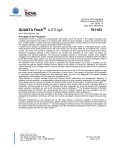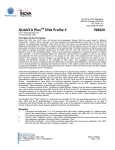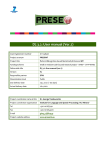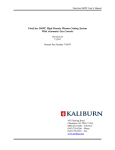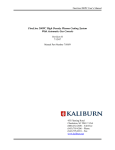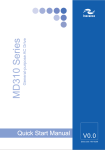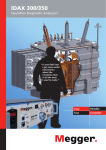Download Product : - Inova Diagnostics
Transcript
TN-BF-006 BIO-FLASH Technical Note Condensation drainage kit BIO-FLASH® Scope A condensation drainage kit has been created to handle water that condenses in the reagent carousel; the water is collected in a bottle to facilitate disposal, or routed directly to a drain. This is an accessory upgrade (optional) as condensation depends on humidity present in the instrument environment and this can be completely different in each installation. For technical service use only Condensation drainage kit Kit Overview Find below the items included in Condensation Drainage Kit package, including this technical note. Page 1 of 14 ECR# 427709 TN-BF-006 BIO-FLASH Technical Note Condensation drainage kit (1) Metal bracket, (2) rigid tube, (3) flexible tubing ( 1 meter ), (4) plastic elbow with grommet and flexible connector, (5) plastic T-junction and (6) 4 feet and 2 washers Prior to installation of the condensation drainage kit, determine where the condensation will be collected. It is recommended that condensation be collected in an empty system rinse bottle, relabelled to identify the bottle as condensation waste. Another reusable bottle may be used instead, so long as it can hold at least 1000ml and is at least 20cm tall. The bottle must be set on a flat, hard surface near the left side of the instrument, with the top of the bottle below the level of the instrument. Alternatively, the condensation may be directed into a sink or other permanent drain, if such a drain is available. This drain must also be below the level of the instrument. For a bottle: Identify where the bottle will be placed. This may be alongside the system rinse and waste bottles or in a separate location. The bottle must be below the level of the instrument and not easily bumped or kicked over, as the connection to the condensation bottle is not sealed. For a drain: Position the instrument so that the left side of the instrument is closest to the sink or drain. The instrument must be no more than 20cm from the edge of the sink. Installation Procedure 1. Remove front and top cover to gain access to reagent carousel, following Service Manual Chapter 7-1. 2. Remove reagent carousel from the unit following Service Manual Chapter 11-1 (take into consideration the fact that the unit has new or old pipettors, internal attachment of cables are different) 3. Add the T-junction (5) to the existing drainage tubes below the reagent carousel as the figure below shows. Page 2 of 14 ECR# 427709 TN-BF-006 BIO-FLASH Technical Note Condensation drainage kit Use warm water to soften the tubing so that the T-junction is fully seated, as shown. Make sure that the open side of the T-junction will be dripping upon the central compartment below the reagent carousel, and that the tubing does not interfere with the encoder on the rotate Page 3 of 14 ECR# 427709 TN-BF-006 BIO-FLASH Technical Note Condensation drainage kit motor. Route the tubing around the motors as shown. Adjust the position of the T-junction so it points straight toward the base casting (up as shown, down when installed). 4. Lay bracket (1) along left side of instrument as shown. Identify which of three exit holes (front, middle, or back) provides most direct route to condensation collection point. Page 4 of 14 ECR# 427709 TN-BF-006 BIO-FLASH Technical Note Condensation drainage kit 5. Lift and prop up the right edge of the instrument, leaving enough room to gain access to the feet and to the hole below the reagent carousel. A wood block is used in the example below. Page 5 of 14 ECR# 427709 TN-BF-006 BIO-FLASH Technical Note Condensation drainage kit foot Elbow attachment hole foot 6. Remove the two feet on the right side of the instrument (looking from the front of the unit), keeping the two washers. Transfer the washers from the old feet to the new feet (higher) and add the two washers provided in the kit to each of the new feet. Install the new feet and washers. Page 6 of 14 ECR# 427709 TN-BF-006 BIO-FLASH Technical Note Condensation drainage kit old new washer Final positioning 7. Place the Elbow (4) screwing it into the hole below the reagent carousel. See images below. Initial position Page 7 of 14 final position ECR# 427709 TN-BF-006 BIO-FLASH Technical Note Condensation drainage kit The elbow must point towards the chosen exit hole in the bracket. When screwing it into the threaded hole the plastic fitting will become threaded. Screw in the elbow until the black grommet contacts the base casting. Continue tightening until the flexible tubing points toward chosen hole in bracket (see step 4). 8. Inspect elbow attachment from top side of base casting to be sure elbow does not extend above level of casting. 9. Attach the rigid tube to the flexible tubing on the elbow by gripping one tube in each hand and pushing together. A gentle twisting movement may be helpful. Push the parts together as far as possible; the rigid tube does not need to reach all the way to the elbow for a secure connection. Verify that the rigid tube lines up with chosen hole in bracket; adjust elbow and/or rigid tube as needed. Page 8 of 14 ECR# 427709 TN-BF-006 BIO-FLASH Technical Note Condensation drainage kit 10. Gently lower right side of instrument to rest on table (removing the block as needed). 11. Lift and prop up left edge of instrument. 12. Remove the old feet and transfer the washers to the new (higher) ones. NOTE: only one washer goes on the left side feet. old Page 9 of 14 new ECR# 427709 TN-BF-006 BIO-FLASH Technical Note Condensation drainage kit 13. Place rigid tubing through selected exit hole in bracket, then attach the bracket to the unit by inserting feet through two holes in top of bracket and screwing into base casting. 14. Remove block and lower instrument onto table. 15. Connect long flexible tubing (3) to rigid tube. Grip one tube in each hand and push together with a gentle twisting motion (about 5mm overlap provides a secure connection). Page 10 of 14 ECR# 427709 TN-BF-006 BIO-FLASH Technical Note Condensation drainage kit 16. Route the flexible tubing to the condensation collection point. Select a clear route for the tubing that minimizes risk of tubing being twisted or pinched, is entirely below the level of the instrument, and slopes downward at all points. The flexible tubing should hang freely with no upturned loops. Disregard upturned loops beyond the bottle/drain as this excess tubing will be removed in the next step. Page 11 of 14 ECR# 427709 TN-BF-006 BIO-FLASH Technical Note Condensation drainage kit Bottle: If any upturned loops are present between the instrument and the bottle, determine an alternate route for the tubing. If necessary choose a different exit hole and/or adjust the position of the bottle to avoid obstacles. Page 12 of 14 ECR# 427709 TN-BF-006 BIO-FLASH Technical Note Condensation drainage kit Sink/Drain: Adjust tubing and/or change exit hole to eliminate upturned loops. If necessary, reposition the instrument. 17. Trim off excess tubing. If using a bottle, trim tubing so it extends ~10cm past mouth of bottle. If using sink, trim tubing so ~10cm hangs into the sink, being sure that end of tubing will not be submerged during sink usage. If using floor drain, trim tubing close to drain, ensuring that the tube slopes downward at all points. 18. If necessary, tape tubing loosely to sink edge/bottle edge etc to keep in place. Testing 1. Re-install reagent carousel to the unit following Service Manual Chapter 11-1 2. Slowly pour 100-200 ml of water into the reagent carousel to verify the integrity of all tubing connections. Look for leaks and adjust as needed. 3. Re-install front and top covers and reagent carousel cover following Service Manual Chapter 7-1. 4. Installation of the kit is complete. Maintenance Emptying bottle If using a bottle to collect condensation, monitor water level in bottle; empty bottle when water level approaches end of flexible tubing. Condensation is not hazardous and can be disposed of in an ordinary drain. Do not allow the bottle to fill up above the end of the flexible tubing as this will prevent proper functioning of the drainage kit. It may be helpful to mark a “max fill” line on bottle to better visualize water level. The rate of condensation collection can vary widely with local climate and time of year. These variables and the size of the collection bottle will affect how often the bottle needs to be emptied. Cleaning system Page 13 of 14 ECR# 427709 TN-BF-006 BIO-FLASH Technical Note Condensation drainage kit Once a year, clean the drainage system by pouring a diluted bleach solution (10%) into the tubing from the reagent carousel holes. Allow the diluted bleach to flow along the drainage line up to the container. Let sit for 20 minutes. Rinse with water. Dispose of bleach solution and subsequent rinse according to local regulations. INOVA Diagnostics, Inc. 9900 Old Grove Road San Diego, CA 92131 United States of America Technical Service (U.S. & Canada Only) : 877-829-4745 Technical Service (Outside the U.S.) : 00+ 1 858-805-7950 E-Mail: [email protected] Page 14 of 14 ECR# 427709














